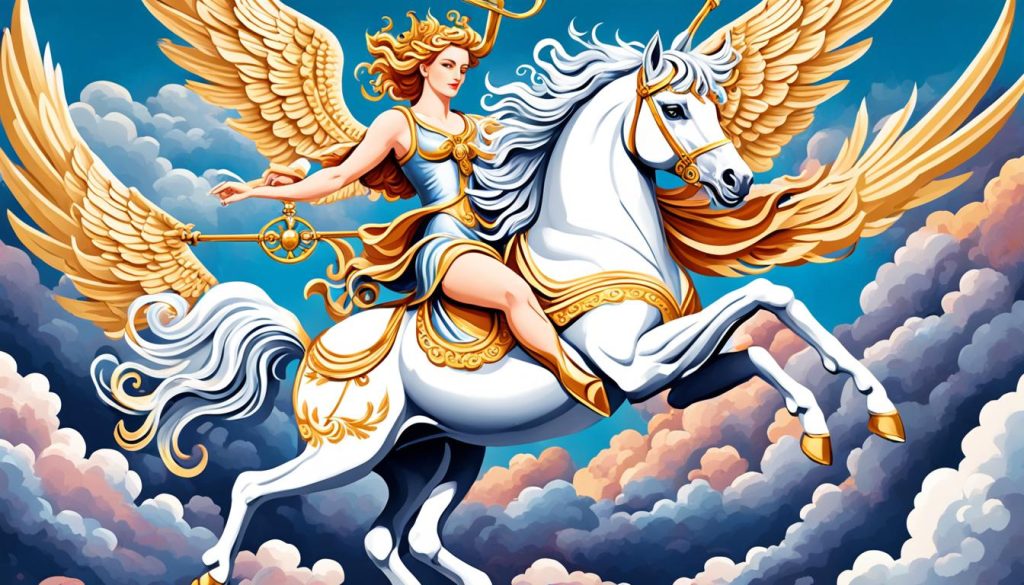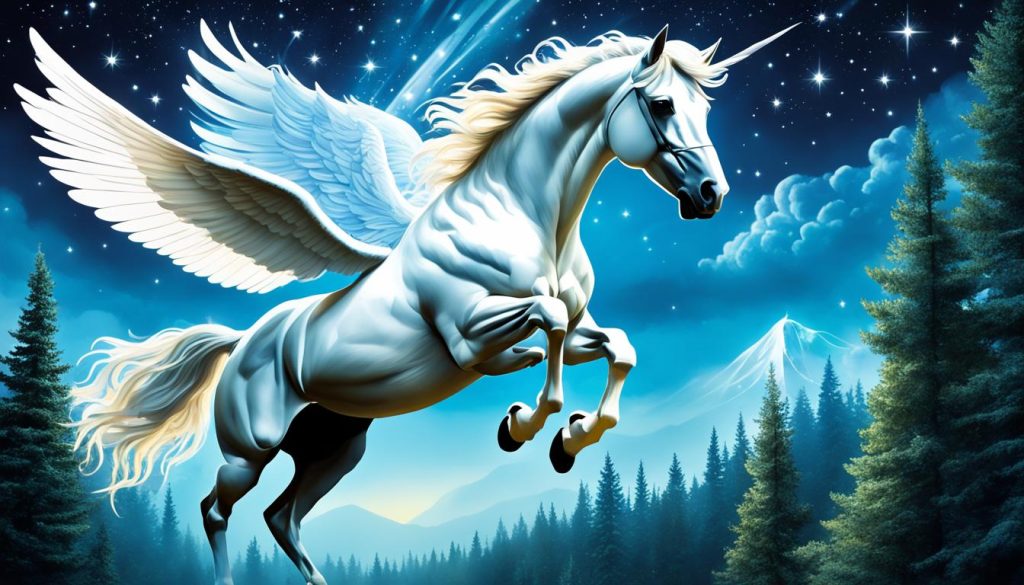Pegasus is a key figure in Greek mythology, known for his beauty and power. He is often seen as a white stallion with wings. His story has been loved by many for centuries.
He comes from the blood of the Gorgon Medusa. This makes him a child of Poseidon, the sea god, and Medusa. His story is full of fantasy, magic, and adventure.
Pegasus’s journey from the earth to the heavens is a tale of wonder. He became known as the one who carried Zeus’s thunderbolts. This makes him a symbol of creativity, power, and the magic of our imagination.
Key Takeaways
- Pegasus is a winged horse from Greek mythology, often depicted as a white stallion.
- Pegasus was born from the blood of the Gorgon Medusa, making him the child of Poseidon and Medusa.
- Pegasus is known for his ascent to the heavens and his service as the thunderbolt bearer for Zeus.
- Pegasus has become a beloved figure in fantasy literature and a symbol of poetic inspiration.
- Pegasus’s story continues to captivate audiences with its elements of fantasy, magic, and the otherworldly.
Origins and Birth
In the world of Greek mythology, Pegasus, the legendary winged horse, has a fascinating story. It says Pegasus came from the blood of the Gorgon Medusa after Perseus cut off her head.
Some stories say Pegasus and his brother Chrysaor came from Medusa’s neck after Perseus beheaded her. Others say they came from Medusa’s blood, pain, and sea foam. This suggests Poseidon, the sea god, was involved.
The name Pegasus means “spring” or “to burst forth” in Greek. This fits how the mythical creature came to life from Medusa’s blood. This story has amazed people for centuries.
From the Blood of Medusa
Pegasus’s birth is tied to the famous Gorgon Medusa. She could turn people to stone with just a look. After Perseus cut off her head, Pegasus and his brother Chrysaor came out of her neck.
Child of Poseidon and Medusa
Another myth says Pegasus and Chrysaor were born from Poseidon, the sea god, and Medusa. This adds a link to the sea and the gods to Pegasus’s story.
The stories of Pegasus’s birth have made him a timeless favorite. His wings and strength have inspired many stories and artworks over the years.
The Winged Steed
Pegasus, the mythical winged horse from Greek mythology, has amazed people for centuries. This magical creature, with its beautiful wings and divine roots, stands for freedom, power, and the endless dreams of humans.
Pegasus was a stunning stallion with white wings. He could fly through the skies, taking gods and heroes with him. His wings let him move between the mortal and divine worlds. This made him a link between the earthly and the heavenly. His stories and links to the gods have made him a key figure in winged horses from Greek mythology.
Pegasus came from the blood of the Gorgon Medusa and had wings because of his divine roots. His flying let him see the ancient Greek world from above. Pegasus’s ties to the gods and his part in many myths have made him a favorite in Greek mythology.
Over time, Pegasus has been celebrated in art, literature, and popular culture. From ancient Greek pottery to Renaissance art, the winged horse keeps showing up. Pegasus’s lasting symbol of freedom, power, and human dreams still moves and inspires people today.
Bellerophon and the Chimera
In the world of Greek heroes, Bellerophon’s story stands out. He defeated the Chimera with courage and smart thinking. This tale shows the bravery and creativity of Greek heroes.
Taming Pegasus
Bellerophon got help from the wise Polyeidos, who told him to sleep in Athena’s temple. Athena showed up in a dream and gave him a golden bridle. This bridle was key to taming Pegasus, the flying horse.
With the bridle, Bellerophon went to the Pierian spring where Pegasus was drinking. He caught and tamed the horse with skill and will. This bond was crucial for his fight ahead.
Slaying the Chimera
With Pegasus by his side, Bellerophon faced the Chimera, a monster with a lion’s head, a goat’s body, and a snake’s tail. From above, he threw arrows and spears, striking the Chimera with a final spear thrust. This defeated the monster-slaying threat.
Bellerophon’s victory over the Chimera is still celebrated today. It shows his bravery, smart thinking, and the strong bond between a hero and his horse. This story still moves and inspires people.
Pegasus and the Muses
In Greek mythology, Pegasus, a magnificent winged horse, was deeply connected to the Muses. These goddesses oversaw the arts and sciences. Their bond was formed at the spring of Hippocrene on Mount Helicon, the Muses’ sacred mountain.
Pegasus’s powerful hoof strike was said to have created the Hippocrene spring. This spring was known for its waters of inspiration for poets and artists. Pegasus’s ability to fly and reach the gods made him a symbol of creativity and the limitless imagination.
The Spring of Hippocrene
The Hippocrene spring, named for “horse’s spring,” came to life with Pegasus’s hoof strike. It was on Mount Helicon, the Muses‘ mountain. Drinking from it was thought to give poets poetic inspiration.
Pegasus, the Muses, and the Hippocrene spring linked the winged horse to art and creativity. Poets and artists have used Pegasus to symbolize the limitless imagination and the spark of creativity.

The story of Pegasus and the Muses still inspires us today. It shows the power of poetic inspiration and the beauty of art. From the Hippocrene spring to great artistic heights, Pegasus symbolizes the creative spirit that keeps reaching for the sky.
Thunderbolt Bearer of Zeus
Pegasus, the majestic winged horse, carried the brave hero Bellerophon and reached the gods’ home on Mount Olympus. Some myths say Pegasus even joined Zeus’s divine group. He was responsible for carrying Zeus’s thunderbolts.
This role made Pegasus a powerful, mythical creature linked to the gods and nature. His ability to fly made him a great match for mighty Zeus. Zeus used thunderbolts that shook the heavens.
Pegasus’s link to Zeus made him a legend in Greek myths. As the divine messenger of Zeus’s thunderbolts, he symbolized the gods’ power. He was a bridge between the mortal and immortal worlds, known for his grace and speed.
The story of Pegasus going to Mount Olympus and serving Zeus shows why people are still fascinated by him. It highlights the captivating tales of ancient Greek gods and their heavenly world.
fantasy
Pegasus, the mythical winged horse, has long captured the hearts of fantasy literature fans. Its magical origins and divine links make it a favorite in magical realism and fairy tales. From ancient Greek epics to today’s fantasy novels and movies, Pegasus symbolizes the power of imagination and the ability to go beyond the otherworldly.
In Greek mythology, Pegasus came from Medusa’s blood, a monster whose look could turn people to stone. Being Poseidon’s son and Medusa’s offspring, Pegasus is powerful and important in fantasy literature.
Pegasus’s skill to fly has made him a hero in fantasy stories. He has been part of many stories, like Bellerophon’s victory over the Chimera, and carrying Zeus’s thunderbolts. For centuries, Pegasus has amazed readers with his role in mythological and legendary tales.
- Pegasus is found in many fantasy literature works, from old Greek epics to modern novels and films.
- His magical beginnings, divine ties, and flying skills have made him a favorite in magical realism and fairy tales.
- Pegasus stands for the power of imagination and going beyond the otherworldly.

Pegasus is a timeless icon in fantasy literature, inspiring many to use their imagination. It flies through stories, helps heroes, and connects the human and divine worlds. This mythical horse still charms and enchants people all over the world.
Pegasus in Art and Literature
Pegasus, the winged horse, has inspired many artists and writers. It has been seen in ancient Greek pottery, Renaissance paintings, and sculptures. This mythical creature has been a key subject in art.
Ancient Greek Pottery
In ancient Greece, Pegasus was often shown with the hero Bellerophon. On pottery, we see Pegasus in scenes like Bellerophon taming it or fighting the Chimera. These images helped make Pegasus a symbol of courage and strength in Greek myths.
Renaissance Paintings and Sculptures
The Renaissance brought back the love for Greek and Roman classics. Pegasus was a big part of the art of this time. Artists made beautiful works inspired by Pegasus myths, showing its beauty and power.
Works like Benvenuto Cellini’s bronze sculpture and Piero di Cosimo’s painting of Bellerophon’s victory over the Chimera are famous. They have made Pegasus a lasting symbol in Western culture.
Through art, Greek art and Renaissance art traditions have shaped our view of Bellerophon and Pegasus. These artworks have made the winged horse a symbol of fantasy and the divine.
Heraldry and Emblems
The mythical Pegasus has left its mark on heraldry and emblems. It’s often seen in British heraldry as a supporter or crest. During World War II, the image of Bellerophon riding Pegasus became the symbol of the British Airborne Forces. It showed the arrival of troops by air.
Pegasus has also been a symbol for companies like Pegasus Airlines from Turkey and Mobil, an American oil company. These examples show how Pegasus is used in many ways. It stands for strength, inspiration, and reaching high goals.
Both military and corporate groups have adopted the Pegasus emblem. It goes from old heraldic crests to today’s logos. Pegasus keeps captivating people. It stands for power, grace, and achieving great heights.